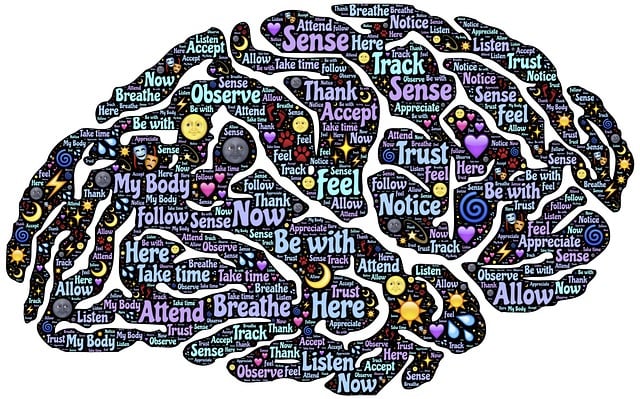Positive thinking exercises integrated into therapy for psychological testing significantly enhance mental wellness by challenging negative thought patterns, reducing anxiety and depression, and boosting life satisfaction. These practices, proven effective in trauma support services, build resilience and self-esteem, enabling individuals to cope with stress more effectively. By adopting an optimistic approach, therapists foster open communication and empathy, leading to improved self-esteem and emotional regulation. Incorporating exercises like compassion cultivation, mental wellness journaling, CBT, mindfulness, gratitude, and positive self-talk into daily routines reprograms the mindset, enhancing self-belief and confidence. Success is measured using a combination of subjective feedback, mood tracking apps, psychological testing, and objective data for tailored self-care and long-term well-being.
“Unleash the power of positivity with positive thinking exercises—a transformative tool in therapy for psychological testing. This comprehensive guide explores how these exercises can enhance well-being and improve mental health outcomes. From understanding the core concept to uncovering the benefits, we delve into practical strategies for implementation. Learn about key components, effective affirmation techniques, and visualization methods to create a powerful routine. Discover how to measure success and customize these practices for optimal results in psychological testing and beyond.”
- Understanding Positive Thinking Exercises
- Benefits of Integrating Positive Thinking in Psychological Testing
- Key Components for Effective Positive Thinking Exercise Implementation
- Strategies for Incorporating Positive Affirmations and Visualizations
- Measuring Success and Adjusting the Positive Thinking Exercise Routine
Understanding Positive Thinking Exercises

Positive thinking exercises are a form of therapy used in psychological testing and mental wellness practices. They’re designed to help individuals cultivate a more positive mindset, which can significantly improve overall well-being. These exercises often involve techniques such as compassion cultivation practices, where one learns to extend kindness and understanding towards oneself and others. Mental wellness journaling is another popular method; it encourages individuals to reflect on their thoughts and emotions, challenging negative thought patterns over time.
Trauma support services also incorporate these exercises to help individuals process and overcome past traumatic experiences. By regularly engaging in positive thinking activities, people can build resilience, boost self-esteem, and enhance their ability to cope with stress. Compassion cultivation practices, for instance, have been shown to reduce symptoms of anxiety and depression while promoting a deeper sense of connection and satisfaction with life.
Benefits of Integrating Positive Thinking in Psychological Testing

Integrating positive thinking into psychological testing offers a multitude of benefits for both therapists and clients. By focusing on optimistic perspectives, therapists can facilitate a more collaborative environment, encouraging open communication and fostering empathy building strategies. This shift in approach not only enhances the therapeutic experience but also contributes to improved self-esteem and emotional regulation among individuals undergoing testing.
Positive thinking exercises enable therapists to assess not just the client’s symptoms but also their overall mental resilience and coping mechanisms. This holistic evaluation allows for tailored interventions, addressing specific needs related to stress management, anxiety reduction, and overall well-being. As a result, therapy for psychological testing becomes more effective, promoting positive outcomes and empowering individuals to navigate life’s challenges with greater confidence and emotional equilibrium.
Key Components for Effective Positive Thinking Exercise Implementation

Implementing effective positive thinking exercises requires a multifaceted approach that incorporates several key components. Firstly, therapy for psychological testing plays a pivotal role in identifying and addressing negative thought patterns. Qualified healthcare providers armed with strong cultural competency training can tailor these exercises to suit diverse individual needs, ensuring inclusivity and relevance. By integrating evidence-based techniques, such as cognitive-behavioral therapy (CBT), practitioners enable clients to challenge and replace unhelpful thoughts with more constructive alternatives.
Additionally, conflict resolution techniques are invaluable in fostering inner strength development. Encouraging individuals to identify sources of stress and negativity allows them to develop coping mechanisms that promote resilience. Exercises focusing on mindfulness, gratitude, and positive self-talk can significantly enhance one’s ability to navigate challenging situations, thereby leading to improved mental well-being and overall life satisfaction.
Strategies for Incorporating Positive Affirmations and Visualizations

Incorporating positive affirmations and visualizations into daily routines can be a powerful tool for anyone looking to enhance their mental wellness. This therapy for psychological testing has been shown to significantly boost self-esteem improvement, making it an invaluable technique in many mental wellness podcast series production. Start by dedicating just a few minutes each day to these practices. Choose affirmations that resonate with you personally; they should be positive statements about yourself and your capabilities. Repeat them out loud, focusing on each word and letting them sink in. For example, “I am worthy of love and respect” or “I have the strength to overcome any challenge.”
Visualizations complement affirmations by allowing you to create mental pictures that support these positive statements. Imagine yourself succeeding in a particular area of your life or achieving a goal. The more detail you can add to this mental image, the more effective it will be. For instance, if you’re working on building confidence, visualize stepping onto a stage and delivering a speech with poise and clarity. By consistently engaging in both affirmations and visualizations, you’ll begin to reprogram your mindset, leading to improved self-belief and an overall confidence boost.
Measuring Success and Adjusting the Positive Thinking Exercise Routine

Measuring success is an integral part of any exercise regimen, including positive thinking practices. While self-reporting can offer valuable insights, integrating external measures such as mood tracking apps or psychological testing tools can provide a more nuanced understanding of progress. These methods allow individuals to quantify improvements in mental health awareness and burnout prevention, ensuring that self-care practices are effectively tailored to their needs.
Adjustments to the positive thinking exercise routine should be based on both subjective feedback from the individual and objective data collected through therapy for psychological testing. By regularly evaluating these factors, practitioners can optimize the program’s effectiveness, ensuring continuous growth and well-being in the long term.
Positive thinking exercises, when integrated into therapy for psychological testing, offer a powerful tool for enhancing well-being. By focusing on key components like affirmations, visualizations, and consistent practice, individuals can harness the benefits of positive thinking to improve their mental health. Regular measurement and adjustments to these routines ensure optimal results, fostering a more optimistic and resilient mindset over time.














